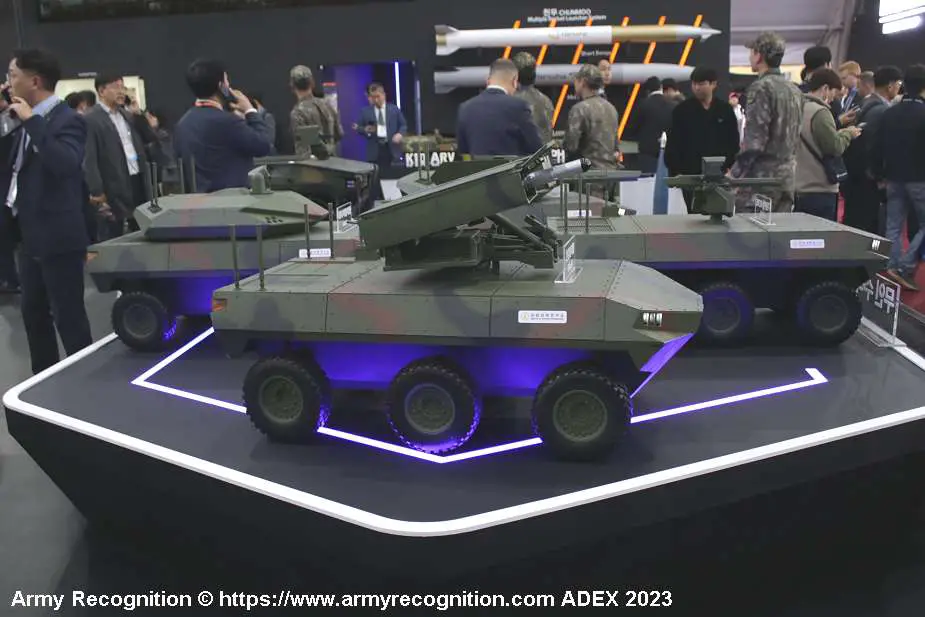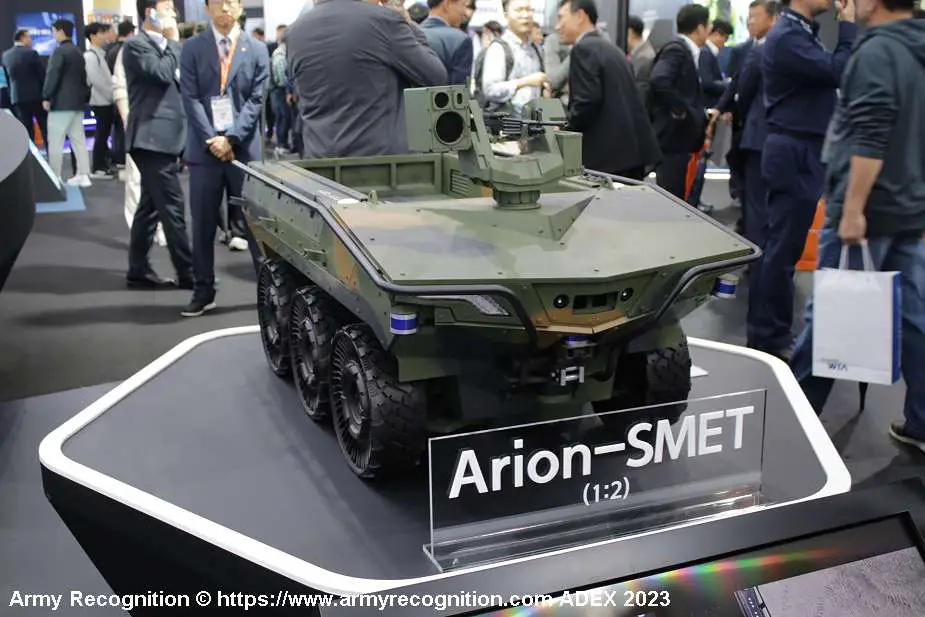Breaking news
Hanwha from South Korea Unveils Advanced UCV-L and Arion-SMET UGVs Robotic Systems.
Seoul, South Korea, October 30, 2023 - At the ADEX 2023 Aerospace and Defense exhibition, Hanwha Aerospace showcased a range of cutting-edge Unmanned Ground Vehicle (UGV) solutions, including the highly anticipated Unmanned Combat Vehicle-Light (UCV-L) and the Arion-SMET robotic system. This innovative vehicle is a product of Hanwha Aerospace's collaboration with the Korean government's Agency for Defense Development.
Follow Army Recognition on Google News at this link

Hanwha displays at ADEX 2023 its full range of UCV-L Unmanned Ground Vehicle- Light projects. (Picture source Army Recognition)
The Korea R&D (Research andd Development) Military Institute is spearheading the project, with Hanwha Aerospace taking the reins for the development and manufacturing of the initial prototypes. Currently, the UCV-L is in its development phase, but its capabilities already promise a significant advancement in modern warfare.
One of the standout features of the UCV-L is its ability to carry a diverse array of modern weapon systems. These include remotely controlled weapon modules equipped with automatic grenade launchers, 30-millimeter cannons, and machine guns. The vehicle's design anticipates its deployment in military operations preceding the entry of mechanized troops and primary armored forces, ensuring a safer and more strategic approach to combat.
Visitors to ADEX were treated to a mockup of the UCV-L, which was displayed in four distinct configurations. These setups showcased the vehicle's versatility, with weapon stations armed with a 12.7mm machine gun, a state-of-the-art laser weapon, an anti-tank guided missile, and a 30mm automatic cannon.
The UCV-L boasts an advanced hybrid motorization system, combining both diesel and electric engines. This design allows for efficient operation, with a single operator having the capability to control two vehicles simultaneously. Unmanned Ground Vehicles (UGVs) equipped with hybrid solutions, which combine traditional internal combustion engines (usually diesel) with electric propulsion systems, offer a plethora of advantages. One of the most significant benefits is the extended range. By seamlessly switching between diesel and electric power, the UGV can operate for extended durations without the need for frequent refueling or recharging. The electric mode can be particularly useful for short-range missions or stealth operations, ensuring minimal noise and thermal signatures.
Furthermore, the versatility of a hybrid system means that the vehicle can adapt to various mission profiles. For instance, the electric mode can be employed in urban environments or sensitive areas where noise and emissions need to be minimized. On the other hand, the diesel engine can be utilized for longer missions or when rapid movement is essential.
The hybrid solution also contributes to reduced operational costs. Electric propulsion, when used, can be more energy-efficient and can lead to savings in fuel costs over time. Additionally, the wear and tear on the internal combustion engine are reduced when the electric system is in operation, potentially extending the lifespan of the UGV.
Moreover, the redundancy provided by having two power sources enhances the reliability and resilience of the UGV. In scenarios where one power source might fail or be compromised, the vehicle can still operate using the other, ensuring mission continuity.
Lastly, as global trends move towards greener and more sustainable technologies, hybrid UGVs align with these objectives by offering a solution that reduces the carbon footprint and environmental impact, especially when the electric mode is prioritized.
In terms of specifications, the UCV-L is no slouch. Weighing in at 9 tons, it can achieve a top speed of 70 km/h. When operating in autonomous mode, it can reach speeds of up to 40 km/h and has an impressive range of 490 km.
With the unveiling of the UCV-L, Hanwha Aerospace solidifies its position as a leader in defense technology, promising a new era of unmanned combat vehicles that are both versatile and formidable.

Mockup of the Arion-SMET robotic system at ADEX 2023. (Picture source Army Recognition)
The Autonomous and Robotic Systems for Intelligence Off-road Navigation – Small Multi-purpose Equipment Transport, abbreviated as ARION SMET, is a cutting-edge 6x6 Unmanned Ground Vehicle (UGV). This 2-ton robot represents an advancement from its 4x4 multipurpose UGV (Unmanned Ground Vehicle) predecessor, developed in 2019 as part of a joint civil-military initiative spearheaded by Hanwha Aerospace. Last year, the South Korean Army conducted successful trials of the ARION-SMET, assessing its tactical operational capabilities.
Designed primarily to aid infantry operations, the Arion-SMET's roles include transporting ammunition and weapons, evacuating injured personnel, conducting remote or autonomous reconnaissance and surveillance, and providing close combat support. Its design emphasizes modularity, allowing it to adapt to a variety of mission requirements.
Key features of the Arion-SMET encompass autonomous off-road navigation, tethering devices for following soldiers or vehicles, autonomous homing capabilities in case of communication breakdowns, and software that supports Manned-Unmanned Teaming (MUM-T) operations.
Equipped with a Deep Neural Network (DNN)--based Remote-Controlled Weapons Station (RCWS), the vehicle can identify and track enemy combatants, pinpoint the origin of gunfire, and respond with targeted fire. These advanced capabilities make the Arion-SMET a valuable asset in MUM-T operations for infantry units.
The electrically powered Arion-SMET boasts impressive mobility, reaching speeds of up to 43 km/h on the road and 34 km/h in all-terrain conditions. With a full charge, it can run at a maximum road speed of 100 km and has a maximum payload capacity of 550 kg.
Defense News October 2023


























